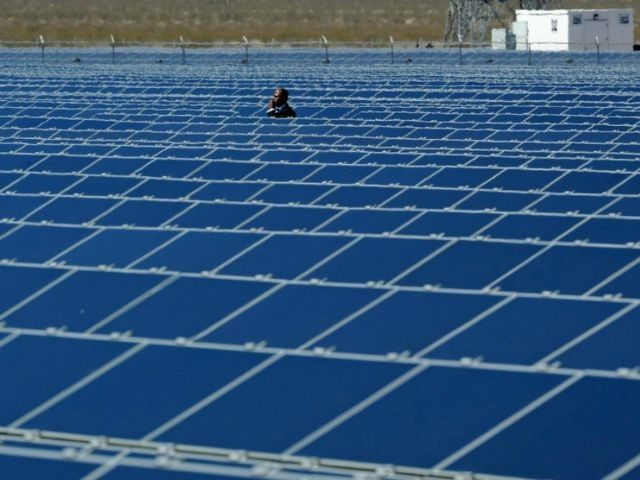President Obama’s Clean Power Plan, released in its final form on Monday, August 3, sparked jubilation in the solar industry. The same day, however, some other news reminded the public of what happens when government policy mandates and incentivizes a favored energy source: Taxpayer dollars are gobbled up and investors lose out.
“The fundamental objective of the Clean Power Plan,” according to Solar Industry Magazine, “is the phasing out of coal-fired power plants in favor of low- or zero-emission sources.” It does this through three “building blocks,” one of which seeks to “increase electricity generation from non-emitting renewable sources, such as solar and wind.”
In a post titled: “How Obama’s Clean Power Plan will fuel the solar industry’s rapid growth,” Forbes.com contributor Lyndsey Gilpin, quotes Shayle Kann, senior vice president of GTM Research: “It could be a major catalyst for solar nationwide.” Gilpin points out: “Apart from the Solar Investment Tax Credit, the federal tax credit for solar, the Clean Power Plan is the first national policy for renewable energy.”
While the excitement from solar proponents is palpable, it is surprising how shameless they are about sucking the government teat while bemoaning the low price of natural gas—which Solar Industry Magazine calls “a fly in the ointment” and “inconvenient.” It blames “new technologies for oil and gas extraction” (no wonder they keep trying to kill hydraulic fracturing). Gilpin states: “in all its 1,560 pages, the Clean Power Plan doesn’t directly address the actual deployment of solar photovoltaic (PV) systems.
As Gilpin points out, “The Clean Power Plan is geared toward centralized utility scale solar, meaning electricity sold to wholesale utility buyers, not end customers.” One such “utility scale solar” company is Abengoa. The Spanish solar company was the single largest recipient of taxpayer funding through Obama’s 2009 Stimulus Bill—$2.8 billion—but has been beset with corruption and allegations that it routinely violates U.S. immigration, environmental, and workplace safety laws. The company, currently under investigation by U.S. Customs and Immigration Service and the Department of Labor, creates spinoffs that enable it to move funds from one to the other, apparently hiding money and falsifying records.
In November 2014, Abengoa bonds were “hammered on accounting concerns,” Reuters reported. It added: “The company has so many different buckets of debt and management has cleverly used this to report reductions in reported net leverage.”
At the time, ratings firm Fitch posted the following: “Fitch will closely monitor management’s response to the current market turmoil and the company’s access to capital markets in the coming days for any further deterioration in the credit profile.”
In another November account, Reuters explains: “Abengoa, an engineering company that expanded massively into renewables, has been struggling with a heavy debt burden since a decade-long economic boom in Spain ended abruptly in 2008.” It must have seen Obama’s push for solar as the answer to its problems. It moved into the U.S. with its hand out and high-profile players—such as former Vice President Al Gore and former New Mexico Governor Bill Richardson—on its team.
I’ve written extensively on Abengoa, as a part of my “Obama’s green-energy, crony-corruption” series, and done a detailed report published by The Daily Caller. I’ve interviewed many former employees and followed its shenanigans. Therefore, I wasn’t surprised when, on August 3—the same day Obama’s Clean Power Plan was touted, headlines announced, once again, that Abengoa shares “plunged.”
Bloomberg reports that the August 3 drop—75.70 percent from its high on September 3, 2014, is because the “company’s plan to shore up capital failed to reassure investors that it can stop burning cash.” Reuters adds: “some analysts are concerned the company is over committing to cash-intensive projects in countries like Brazil and Mexico rather than focusing on cutting debt.”
Abengoa, which went public (NASDAQ) on October 17, 2013 at an opening share price of $12.37, once enjoyed a “top pick” and “safest” moniker, hit a high of $28.88 on September 3, 2014 but has now nosedived to $6.50. The law firm Levi & Korinsky—which claims it has “extensive expertise in prosecuting securities litigation involving financial fraud, representing investors throughout the nation in securities lawsuits, and has recovered hundreds of millions of dollars for aggrieved shareholders”—now investigates Abengoa and its Board of Directors for possible violations of federal securities laws.
A former human resources director at one of Abengoa’s subsidiaries, who served as my “deep throat” in earlier reporting, said: “What I came to realize, and it took me a while because I didn’t want to realize it, is that they understood. They knew the law. They didn’t care. I really came to believe that they’re so politically connected that it’s just hubris and arrogance.”
Today, this “top pick” has a 76.9 percent “probability of bankruptcy.” Our taxdollars that won’t be paid back.
So, when you hear the solar power proponents chirping about regulations that encourage investment in solar, incentives to help families, and mechanisms to increase deployment, remember they are taking our tax dollars and giving them to companies like Abengoa that get the funding because of connections.
They win. We lose.
The author of Energy Freedom, Marita Noon serves as the executive director for Energy Makes America Great Inc. and the companion educational organization, the Citizens’ Alliance for Responsible Energy (CARE). She hosts a weekly radio program: America’s Voice for Energy—which expands on the content of her weekly column. Follow her @EnergyRabbit.

COMMENTS
Please let us know if you're having issues with commenting.
*** This article has also been posted to Breitbart's Facebook page. Join the conversation on Facebook.